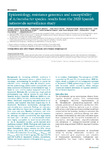Epidemiology, resistance genomics and susceptibility of Acinetobacter species: results from the 2020 Spanish nationwide surveillance study

Use este enlace para citar
http://hdl.handle.net/2183/37791Colecciones
- Investigación (FIC) [1685]
Metadatos
Mostrar el registro completo del ítemTítulo
Epidemiology, resistance genomics and susceptibility of Acinetobacter species: results from the 2020 Spanish nationwide surveillance studyAutor(es)
Fecha
2024-04-11Cita bibliográfica
Lasarte-Monterrubio Cristina, Guijarro-Sánchez Paula, Alonso-Garcia Isaac, Outeda Michelle, Maceiras Romina, González-Pinto Lucia, Martínez-Guitián Marta, Fernández-Lozano Carlos, Vázquez-Ucha Juan Carlos, Bou German, Arca-Suárez Jorge, Beceiro Alejandro. Epidemiology, resistance genomics and susceptibility of Acinetobacter species: results from the 2020 Spanish nationwide surveillance study. Euro Surveill. 2024;29(15):pii=2300352. https://doi.org/10.2807/1560-7917.ES.2024.29.15.2300352
Resumen
[Abstract]:
Background:
As increasing antibiotic resistance in Acinetobacter baumannii poses a global healthcare challenge, understanding its evolution is crucial for effective control strategies.
Aim:
We aimed to evaluate the epidemiology, antimicrobial susceptibility and main resistance mechanisms of Acinetobacter spp. in Spain in 2020, and to explore temporal trends of A. baumannii.
Methods:
We collected 199 single-patient Acinetobacter spp. clinical isolates in 2020 from 18 Spanish tertiary hospitals. Minimum inhibitory concentrations (MICs) for nine antimicrobials were determined. Short-read sequencing was performed for all isolates, and targeted long-read sequencing for A. baumannii. Resistance mechanisms, phylogenetics and clonality were assessed. Findings on resistance rates and infection types were compared with data from 2000 and 2010.
Results:
Cefiderocol and colistin exhibited the highest activity against A. baumannii, although colistin susceptibility has significantly declined over 2 decades. A. non-baumannii strains were highly susceptible to most tested antibiotics. Of the A. baumannii isolates, 47.5% (56/118) were multidrug-resistant (MDR). Phylogeny and clonal relationship analysis of A. baumannii revealed five prevalent international clones, notably IC2 (ST2, n = 52; ST745, n = 4) and IC1 (ST1, n = 14), and some episodes of clonal dissemination. Genes blaOXA-23, blaOXA-58 and blaOXA-24/40 were identified in 49 (41.5%), eight (6.8%) and one (0.8%) A. baumannii isolates, respectively. ISAba1 was found upstream of the gene (a blaOXA-51-like) in 10 isolates.
Conclusions:
The emergence of OXA-23-producing ST1 and ST2, the predominant MDR lineages, shows a pivotal shift in carbapenem-resistant A. baumannii (CRAB) epidemiology in Spain. Coupled with increased colistin resistance, these changes underscore notable alterations in regional antimicrobial resistance dynamics.
Palabras clave
Acinetobacter baumannii
Carbapenem-resistant
OXA-23
Nosocomial infection
Carbapenem-resistant
OXA-23
Nosocomial infection
Versión del editor
Derechos
Atribución 3.0 España
ISSN
1560-7917






